When it comes to controlling disease-causing pathogens, lagoons do it better—but do they do it well enough?

The purpose of wastewater treatment is to remove before discharge any substance that can have a negative effect on the environment. In previous articles, we’ve discussed BOD removal, nutrients like ammonia and phosphorus, and contaminants like pharmaceuticals and personal care products.
In this article we’ll discuss what pathogens are, how well lagoon treatment works in removing them (pretty well, as it turns out), and how to optimize lagoon pathogen removal and disinfection.
While lagoons have been providing sufficient pathogen control for many years, some regulating bodies are increasing the required standard of treatment, in which case it’ll be necessary to add a tertiary step to the lagoon process to meet higher levels of disinfection. We’ll cover that, too.
What are Wastewater Pathogens?

Pathogens are disease-causing organisms, including bacteria, viruses, and parasites, which are likely present in all wastewater. Water contaminated with pathogens can transmit bacterial and viral diseases like typhoid fever, dysentery, cholera, polio, hepatitis, and Norwalk gastroenteritis; and parasitic diseases like Giardia and hookworm. That’s why it’s so critically important that wastewater be disinfected before being discharged back into the environment.
Most wastewater treatment facilities are required to test for E. coli or fecal coliform bacteria, which are widely used as indicator organisms to determine the effectiveness of the disinfection process. Because different pathogens have different die-off rates, fecal coliform alone is just a snapshot, not the full picture.
Pathogen Removal: Lagoons Do It Better
Wastewater lagoons are typically better at removing fecal coliform bacteria and other pathogens than conventional mechanical plants, because long retention times, exposure to sunlight, dissolved oxygen (DO), and settling are keys to pathogen removal. Other factors that affect die-off include temperature (with removal better in warm temperatures than in cold), pH, algae, and predation by competitive microorganisms.
Maximizing Lagoon Pathogen Removal
Retention time
Anything that enhances retention time in a wastewater lagoon system benefits pathogen removal. Ways to increase retention time include:
- Preventing short circuiting, or influent bypassing the treatment process due to poor lagoon design or stratification. According to Biological Wastewater Treatment: Principles, Modelling and Design, edited by M. Henze, “a major drawback of ponds is the potential for short-circuiting…. Even though the amount of short-circuiting may be small, detectable levels of pathogens can often be found in the effluent….” Our article How to Prevent Wastewater Lagoon Short Circuit covers this subject in detail. Mixing and aeration prevent the thermal stratification and sludge buildup that can lead to short circuiting.
- Adding baffles to mitigate undertreatment by creating a longer flow length for wastewater to travel and by disrupting the effects of wind shear and influent surges.
- Running cells in series, not parallel. According to the EPA’s Performance and Upgrading of Wastewater Stabilization Ponds, multiple studies have demonstrated that “series operation of lagoon systems produce better bacterial quality effluents than do single-celled systems.”
Sunlight
Solar radiation is critical to the disinfection process. Take advantage of it by:
- Keeping the surface of the water clear of sunlight-blocking debris, aquatic plants like duckweed, and algae.
- Drawing effluent from the upper surface of the final pond.
- Discharging during the afternoon to maximize sun exposure.
Aeration
According to a study published in Applied and Environmental Microbiology, “The ability of light to damage fecal coliforms was highly sensitive to, and completely dependent on, oxygen.” Further, a study published in the International Journal of Environmental Research and Public Health found that populations of Salmonella bacteria decreased more rapidly in aerated wastewater than in nonaerated.
Settling

While pathogenic microbes have short lives outside a host organism and can be removed through sunlight and retention time, parasites are removed mostly through sedimentation. The eggs of parasites like helminths and nematodes can live in sludge for years, so proper sludge handling is crucial. Lagoon consultant Steve Harris, in his manual Wastewater Lagoon Troubleshooting, recommends taking a polishing pond off line if sludge is to be disturbed, and allowing time for it to settle after mixing.
Enhanced Disinfection
As regulatory agencies are increasingly requiring higher levels of disinfection, it may be necessary to add treatment to ensure that virtually all pathogenic organisms are destroyed before effluent is discharged. The mostly widely used disinfection processes are chlorination and ultraviolet (UV) light systems.
Chlorination
Chlorine is a popular method of disinfection in municipal wastewater systems because it is reliable, offers flexible dosing, and is cost-effective. The downside is that chlorine is highly corrosive and toxic, and therefore difficult to handle and store; and as chlorine is toxic to aquatic life, treatment often requires an addition of a dechlorination step before discharge.
UV light
UV disinfection is becoming an attractive alternative to chlorine as design improvements have reduced costs. UV is user-friendly and effective, and because it is a physical process, there is no need to purchase, store, or handle toxic chemicals, and there is no residual effect that could be harmful to the environment.
Check out the State of Michigan Department of Natural Resources & Environment’s invaluable Training Manual for Operators of Wastewater Stabilization Lagoons for detailed information about lagoon effluent disinfection via chlorine and UV light.
Pathogen Removal: Meeting Effluent Standards
When it comes to pathogen removal, it’s true that Lagoons Do It Better than conventional mechanical plants, but, as effluent standards become tighter, probably not well enough, especially in continuous discharge systems or those with short retention times. Lagoon operators may need to add a polishing step for final disinfection, depending on regulatory limits.

